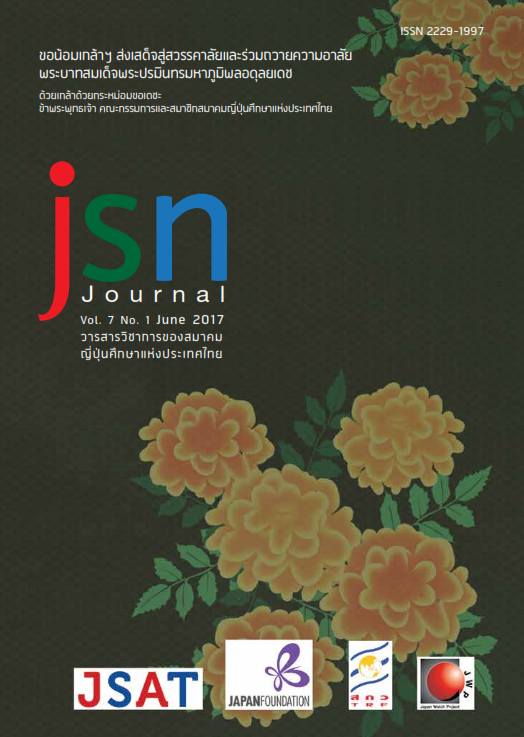การศึกษาความวิตกกังวลในการเรียนรู้ภาษาญี่ปุ่นของผู้เรียนระดับต้นที่มีพื้นฐานภาษาญี่ปุ่นแตกต่างกัน
Main Article Content
บทคัดย่อ
งานวิจัยนี้มีวัตถุประสงค์ 1) เพื่อศึกษาความวิตกกังวลในการเรียนรู้ภาษาญี่ปุ่นของผู้เรียนระดับต้น และ 2) เปรียบเทียบความวิตกกังวลของผู้เรียนที่มีพื้นฐานและไม่มีพื้นฐานในการเรียนรู้ภาษาญี่ปุ่นก่อนเข้ามหาวิทยาลัย เครื่องมือที่ใช้วิจัยคือ แบบสอบถามความวิตกกังวลซึ่งประกอบด้วยปัจจัยต่าง ๆ ที่ส่งผลต่อการเรียนภาษาญี่ปุ่น งานวิจัยนี้วิเคราะห์ข้อมูลด้วยค่าเฉลี่ยและสถิติทดสอบค่าที ผลการศึกษาพบว่า ผู้เรียนระดับต้นมีความวิตกกังวลในการเรียนรู้ภาษาญี่ปุ่นระดับมาก ได้แก่ ความวิตกกังวลเกี่ยวกับเพื่อนคนอื่น ๆ ที่เรียนร่วมชั้น การเรียนรู้ไวยากรณ์ภาษาญี่ปุ่น และความกลัวต่อการผิดพลาด ในสี่ทักษะสอดคล้องกัน ส่วนผลการเปรียบเทียบความวิตกกังวลของผู้เรียนที่มีพื้นฐานและไม่มีพื้นฐานในการเรียนรู้ภาษาญี่ปุ่นก่อนเข้ามหาวิทยาลัยพบว่า ผู้เรียนมีความวิตกกังวลแตกต่างกันอย่างมีนัยสำคัญที่ระดับ .05 สอดคล้องกันทั้งสี่ทักษะ โดยผู้เรียนที่มีพื้นฐานมีความวิตกกังวลที่เกี่ยวข้องกับเพื่อนคนอื่น ๆ ที่เรียนร่วมชั้นน้อยกว่าผู้เรียนที่ไม่มีพื้นฐาน ปัจจัยที่ส่งผลให้เกิดความวิตกกังวลในลักษณะดังกล่าว คือ การสะท้อนผลและการประเมินผลผู้เรียน
Article Details
ข้อความและข้อคิดเห็นต่างๆ ในบทความเป็นของผู้เขียนบทความนั้นๆ ไม่ใช่ความเห็นของกองบรรณาธิการหรือของวารสาร jsn Journal
เอกสารอ้างอิง
ชัชวาล เรืองประพันธ์. (2539). สถิติพื้นฐาน: พร้อมยกตัวอย่างการวิเคราะห์ด้วยโปรแกรม MINITAB SPSS/PC+ และ SAS (พิมพ์ครั้งที่ 2 ฉบับปรับปรุง). ขอนแก่น: โรงพิมพ์คลังนานาวิทยา.
บุญชม ศรีสะอาด. (2545). การวิจัยเบื้องต้น (พิมพ์ครั้งที่ 7). กรุงเทพฯ: สุวีริยาสาส์น บุญธรรม.
ธานินทร ศิลป์จารุ. (2548). การวิจัยและการวิเคราะห์ข้อมูลทางสถิติด้วย SPSS. กรุงเทพฯ: วี.อินเตอร์ พริ้นท.
Aida, Y. (1994). Examination of Horwitz, Horwitz, and Cope’s construction of foreign language anxiety: The case of students of Japanese. The Modern Language Journal, 78(2), 155-168. doi: 10.1111/j.1540-4781.1994.tb02026.x
Antony, M.M., & Swinson, R.P. (1998). When perfect isn’t good enough: Strategies for coping with perfectionism. Oakland, CA: New Harbinger.
Bailey, P., Onwuegbuzie, A.J., & Daley, C. E. (2000). Correlates of anxiety at three stage of the foreign language learning process. Journal of Language and Social Psychology, 19(4), 474-490. doi: 10.1177/0261927x00019004005
Cheng, Y. S. (2004). A measure of second language writing anxiety: Scale development and preliminary validation. Journal of Second of Language Writing, 30(4), 313-335.
Elkhafaifi, H. (2005). Listening comprehension and anxiety in the Arabic language classroom. The Modern Language Journal, 89(2), 206-220. doi: 10.1111/j.1540-4781.2005.00275.x
Eysenck, M. W. (1991). Trait anxiety and cognition. In C. D. Spielberger, I. G. Sarason, Z. Kulcsar,& G. L. Van Heck (Eds.), Stress and emotion: Anxiety, anger and curiosity (Vol.14, pp. 77–84). New York: Hemisphere.
Gass, S. M., & Selinker, L. (2001). Second language acquisition: An introductory course,(2nd ed.). Mahwah, NJ: Laurence Erlbaum Associates.
Gregersen, T., & Horwitz, E. K. (2002). Language leaning and perfectionism: Anxious and non-axnious language learners’ reactions to their own oral performance. The Modern Language Journal, 86(4), 562-570.
Kara, S. (2013). Writing anxiety: A case study on students’ reasons for anxiety in writing classes. Anadolu Journal of Educational Sciences International, 3(1), 104-111.
Kitano, K. (2001). Anxiety in the college Japanese language classroom. The Modern Language Journal, 85(4), 549-566. doi: 10.1111/0026-7902.00125
Krashen, S. D. (1982). Principles and practice in second language acquisition. Oxford: Pergamon. Retrieved from http://sdkrashen.com/content/books/principles_and_practice.pdf
Machida, T. (2010). Foreign language anxiety among intermediate-level university student of Japanese. Proceeding of the 22nd Annual Conference of the Central Association of Teacher of Japanese, CATJ22 @ Purdue University, 62-75. Retrieved from https://www.cla.purdue.edu/academic/slc/l/japanese/CATJ22_Proceedings.html
MacIntyre, P. D., & Grardner, R. C. (1994). The subtle effect of language anxiety on cognitive processing in the second language. Language Learning, 44(2), 283-305. doi: 10.1111/j.1467-1770.1994.tb01103.x
MacIntyre, P. D., Noels, K. A., & Clément, R. (1997). Biases in self-ratings of second language proficiency: The role of language anxiety. Language Learning, 42(2), 265-287. doi: 10.1111/ 0023-8333.81997008
Matsuda, S., & Gobel, P. (2004). Anxiety and predictors of performance in the foreign language classroom. System, 32(1), 21-36. doi: 10.1016/j.system.2003.08.002
Oxford, R. L. (1999). Anxiety and language learner: New insights. In Jane Arnold (Ed.), Affect in language learning (4th ed., pp. 58-67). Cambridge, UK: Cambridge University Press.
Saito, Y., Horwitz, E. W., & Garza, T. J. (1999). Foreign language reading anxiety. The Modern Language Journal, 86(2), 202-218. doi: 10.1111/0026-7902.0016
Scovel, T. (1969). Foreign accents language acquisition, and cerebral dominance research. Language Learning, 19, 245-253.
Seliger, H., Krashen, S., & Ladefoged, P. (1975). Maturational constraints in the acquisition of second languages. Language Sciences, 38, 20-22.
Selinger, H. W. (1978). Implications of a multiple critical periods hypothesis for second language learning. In second language acquisition research: Issue and Implications, William C. Ritchie (ed.), 11-19. New York: Academic Press.
Strongman, K. T. (1995). The theories of anxiety. New Zealand Journal of Psychology, 24(2), 4-10.
Zhang, X. (2013). Foreign language listening anxiety and listening performance Conceptualization and causal relationships. System,41(1), 164-177. doi: 10.1016/j.system.2013.01.004
国際交流基金関西センター(2012a). 『日本語能力試験 JLPT Japanese-Language Proficiency Test 公式問題集 N5』 凡人社.
国際交流基金関西センター(2012b). 『日本語能力試験 JLPT Japanese-Language Proficiency Test 公式問題集 N4』 凡人社.
国際交流基金関西センター(2012c). 『日本語能力試験 JLPT Japanese-Language Proficiency Test 公式問題集 N3』 凡人社.
元田静 [Motoda] (1997). 「初級日本語学習者の第二言語教室不安についての基礎的調査」 『第二言語不安の理論と実態』.渓水社, 61-73.


